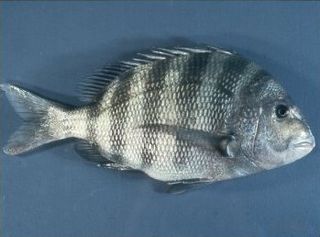
Archosargus probatocephalus, the sheepshead, sheepshead seabream or convict fish, is a species of marine ray-finned fish belonging to the family Sparidae, the seabreams and porgies. This species is found in the Western Atlantic Ocean. The sheepshead is an important species to recreational and commercial fisheries.

The Priacanthidae, the bigeyes, are a family of 18 species of marine ray-finned fishes. "Catalufa" is an alternate common name for some members of the Priacanthidae. The etymology of the scientific name refers to the family's very rough, spined scales. The common name of "bigeye" refers to the member species' unusually large eyes, suited to their carnivorous and nocturnal lifestyles. Priacanthidae are typically colored bright red, but some have patterns in silver, dusky brown, or black. Most species reach a maximum total length of about 30 cm (12 in), although in a few species lengths of over 50 cm (20 in) are known.
Catalufa is the common name for three species of fish belonging to the family Priacanthidae:
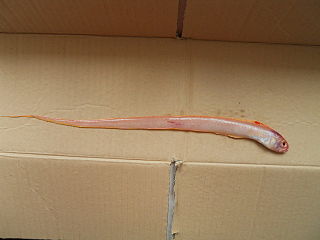
The bandfishes, family Cepolidae, are 23 species of marine ray-finned fishes, They are native to the East Atlantic and Indo-Pacific wherethey dig burrows in sandy or muddy seabeds and eat zooplankton.
Scombrops oculatus, the Atlantic scombrops, is a species of marine ray-finned fish, a gnomefish from the family Scombropidae. It is found in the Western Atlantic Ocean.
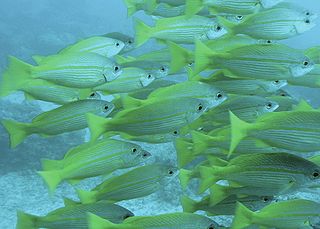
The bigeye snapper, also known as the bigeye seaperch, red sea lined snapper, golden striped snapper, rosy snapper, yellow snapper, or simply snapper, is a species of marine ray-finned fish, a snapper belonging to the family Lutjanidae. It is native to the Indian Ocean and the western Pacific Ocean. It is the type species of the genus Lutjanus.

Heteropriacanthus, the glasseyes or glass bigeyes, are a genus of the bigeye family found in all tropical seas around the world. It occasionally makes its way into the aquarium trade. It grows to a size of 50.7 cm (20.0 in) in total length.

The razorback scabbardfish, Assurger anzac, is a rare species of cutlassfish, family Trichiuridae, and the only member of its genus. It has been caught from scattered locations worldwide: in the Atlantic Ocean it is known from off Puerto Rico, Uruguay, and the Walvis Ridge, in the Indian Ocean it is known from off western Australia, and in the Pacific Ocean it is known from off New Guinea, southern Japan, Midway Island, California, and the Nazca and Sala y Gomez Ridges. Adults are thought to be benthopelagic, occurring at a depth of 150–400 meters (490–1,310 ft), while juveniles are found near the surface or in midwater.

Bellator egretta, the streamer searobin, is a species of marine ray-finned fish belonging to the family Triglidae, the sea robins. This fish is found in the western Atlantic Ocean.
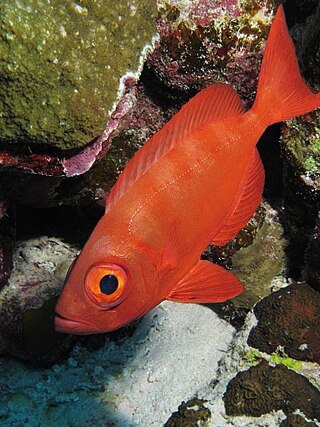
Priacanthus hamrur, the lunar-tailed bigeye, goggle eye, or moontail bullseye, is a species of marine fishes belonging to the family Priacanthidae.
Owstonia taeniosoma is a species of marine ray-finned fish belonging to the family Cepolidae, the bandfishes. It is known from the Indo-West Pacific region.
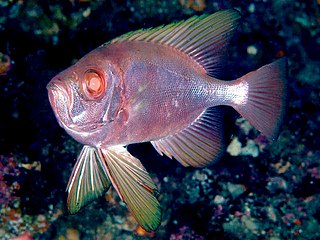
Cookeolus japonicus is a species of fish in the family Priacanthidae, the bigeyes and catalufas. It is the only extant species of Cookeolus, except for C. spinolacrymatus, an extinct Late Pliocene fish known from a fossil specimen collected in Okinawa, Japan.

Taractichthys steindachneri, the sickle pomfret, is a species of marine ray-finned fish, a pomfret of the family Bramidae. It is found in the Indian and Pacific Oceans.

Pristigenys is a genus of marine ray-finned fish in the family Priacanthidae. It contains five extant species and one extinct species, P. substriata, which is known from fossils found in the Eocene of Monte Bolca, Italy.

Pristigenys niphonia, the Japanese bigeye, is a species of marine ray-finned fish in the family Priacanthidae. It occurs in the western Pacific Ocean.
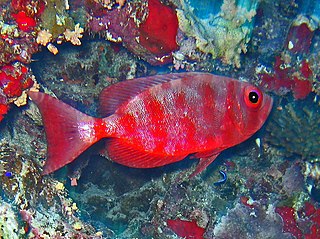
Priacanthus is a genus of marine ray-finned fishes belonging to the family Priacanthidae, the bigeyes. As of 2012 there are 12 species in the genus.
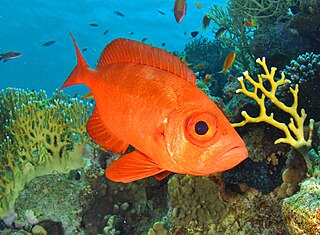
Priacanthus blochii, the paeony bulleye, is a species of marine ray finned fish, a bigeye in the family Priacanthidae. Other common names for this species include Bloch's bigeye, blotched bigeye, glass-eyebigeye, shortfin bigeye, silver big-eye and goggle eye.
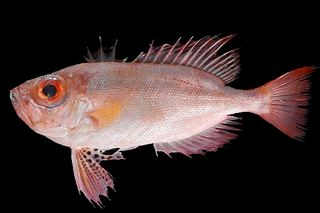
Priacanthus tayenus, commonly known as purple-spotted bigeye, is a species of marine ray finned fish, a bigeye in the family Priacanthidae. It is native to the Indian and Pacific Oceans.

Priacanthus sagittarius, The arrow bulleye, is a species of marine ray finned fish, a bigeye in the family Priacanthidae. It is native to the Indian and Pacific Oceans. It is also observed since 2009, in rare occasions, in the eastern Mediterranean Sea, which it most likely entered via the Suez Canal.

Priacanthus arenatus, the toro or Atlantic bigeye, is a species of marine ray finned fish, a bigeye in the family Priacanthidae. Some anglers refer to this fish as "toro snapper", but it is not a snapper, and only distantly related to the fish of the snapper family. It is found across much of the Atlantic ocean.

















